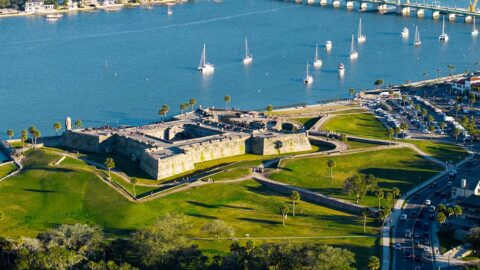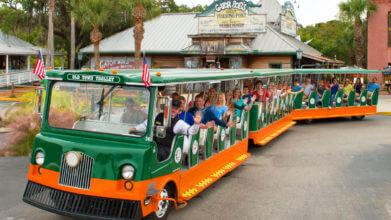Historic Forts & Castles of St. Augustine

Discover the Timeless Charm of St. Augustine’s Historic Forts and Castles
St. Augustine, known as America’s oldest city, is a place full of history and stunning old buildings. The historic forts and castles around this city hold stories from when Spanish explorers founded St. Augustine in 1565 to its days as a key military spot. These impressive stone buildings let visitors step back in time to see the rich cultural heritage and smart designs that protected St. Augustine during its early days. Dive into the past and explore these famous landmarks that make St. Augustine a must-visit for history lovers.
Castillo de San Marcos
History and Facts
 In 1672, construction began on the Castillo de San Marcos, and it took 23 years to complete. This fort was built from a stone called coquina, which is a limestone made with seashells and was tougher than earlier ones and could withstand attacks and fires. Even when British forces attempted several times to conquer it, they couldn’t break through its walls. After the Treaty of Paris in 1763, the fort changed hands from the Spanish to the British and became a prison during the Revolutionary War. In 1900, it ceased operation as an active military site. Shortly after, in 1924, the fort became a celebrated national monument, taking back its original Spanish name, Castillo de San Marcos.
In 1672, construction began on the Castillo de San Marcos, and it took 23 years to complete. This fort was built from a stone called coquina, which is a limestone made with seashells and was tougher than earlier ones and could withstand attacks and fires. Even when British forces attempted several times to conquer it, they couldn’t break through its walls. After the Treaty of Paris in 1763, the fort changed hands from the Spanish to the British and became a prison during the Revolutionary War. In 1900, it ceased operation as an active military site. Shortly after, in 1924, the fort became a celebrated national monument, taking back its original Spanish name, Castillo de San Marcos.
Things To Do at Castillo de San Marcos
At this fort, you can watch history come to life. Climb the ancient walls for a stunning view of Matanzas Bay and the city. Inside, you’ll find exhibits with old maps and artifacts that tell more about the fort’s history. The park rangers also host educational programs and fun events like reenactments and daily cannon firings, making history engaging for everyone. The Castillo is easily accessible as a stop on the Old Town Trolley.
Fort Matanzas
History and Facts
Built in 1742, Fort Matanzas was designed to protect a vulnerable back entry point into St. Augustine. After a close call during a 39-day siege in 1740, the Spanish realized they needed a fort at Matanzas Inlet. Using convict and slave labor, they quickly set up this smaller fort to stop any future threats. Today, Fort Matanzas reminds us of the lengths to which the old city went to protect itself. The fort’s strategic placement and design reflect the multicultural influences of Spanish and native engineering techniques that have shaped St. Augustine’s defense structures.
Things To Do at Fort Matanzas
Take a short ferry ride to see Fort Matanzas up close. You can have a picnic, go fishing, or hike the nature trails. The park rangers are there to teach you about the fort’s history, and kids can join in the Junior Ranger program to learn in a fun way. Additionally, visitors can explore the marshy areas around the fort to catch a glimpse of Florida’s native wildlife and the unique ecosystems that the early settlers had to contend with.
Fort Mose
History and Facts

Things To Do at Fort Mose
Today, you can visit the Fort Mose Museum to learn about this fascinating part of American history and how the African culture blended with the Spanish, English, and indigenous cultures in the area to create entirely unique customs and traditions. The park offers canoeing, kayaking, and a chance to see wildlife on the boardwalk. There are also picnic spots and a variety of educational programs that make learning about this historic site exciting. This area is also well-known with geocachers, and you’re invited to try your luck in finding whatever treasures they may have left in the area. Seasonal cultural festivals and reenactments bring the vibrant history of Fort Mose to life, offering a deeper connection to the stories of its inhabitants.
Castle Otttis
History and Facts
Castle Otttis, an imaginative recreation of an Irish castle, was built between 1984 and 1988. It was never meant to be a home, but rather, a piece of landscape art, open to the weather and towering over 50 feet high. Although initially mistaken for a garage in official records, it stands as a monument to creative spirit and craftsmanship, featuring stunning woodwork and an open design that invites the elements in.
Things To Do at Castle Otttis
Explore the unique design and history of Castle Otttis, take in the panoramic views, and enjoy special events held at this striking structure. It’s a perfect spot for photography and soaking up the atmosphere of a castle that feels both ancient and new. Visitors can also participate in guided tours that explain the architectural features and artistic inspirations behind this unique building. Please note that Castle Otttis does not have handicapped access.
Castle Warden
History and Facts

Things To Do at Castle Warden
Visit Castle Warden to marvel at the architectural beauty and explore the Ripley’s Believe It or Not! museum. The museum provides a fun and unusual experience, showcasing a range of bizarre and fascinating exhibits.
Zorayda Castle
History and Facts
Built in 1883 by Bostonian entrepreneur and architect Franklin W. Smith, Villa Zorayda is a stunning example of Moorish Revival architecture. Inspired by the Alhambra Palace in Granada, Spain, Smith sought to recreate the opulence and mystique of this iconic landmark in the heart of St. Augustine. His extensive travels and fascination with ancient civilizations fueled his desire to create not just a home but an educational experience.
Smith’s innovative use of poured concrete, a first for Florida, allowed him to construct a fireproof and durable structure. This groundbreaking technique would later influence the architecture of St. Augustine, including Henry Flagler’s iconic buildings.
After serving as Smith’s winter retreat, Villa Zorayda transformed into the Zorayda Club, a social hub for St. Augustine’s elite. The building later hosted a gambling casino and speakeasy before becoming a museum in the 1930s under the ownership of the Mussallem family.
The Mussallems dedicated their lives to preserving this architectural treasure. Through generations of stewardship, they meticulously restored and maintained the villa, ensuring its legacy for future generations. Today, Zorayda Castle offers visitors a glimpse into a bygone era, showcasing the rich history of St. Augustine and the artistic vision of its creators.
Things To Do at Zorayda Castle

FAQs
What are some family-friendly historic forts and castles to visit in St. Augustine?
Families will find Castillo de San Marcos and Fort Matanzas perfect for a day out, with interactive exhibits and programs that engage visitors of all ages. These sites offer not only historical insights but also activities that are enjoyable and educational for children and adults alike.
Which is the oldest fort in St. Augustine?
The oldest fort in St. Augustine is Castillo de San Marcos, built in 1672 and a cornerstone of the city’s history. Its robust construction and fascinating history make it a highlight for any visitor to St. Augustine.
What can families expect when visiting Castillo de San Marcos?
Families visiting Castillo de San Marcos can expect a fun-filled day with plenty of educational activities. The fort offers a chance to learn about military history through engaging tours and hands-on exhibits. It’s a place where history comes alive, making it exciting and accessible for young learners and their families.
Is Fort Matanzas suitable for younger children?
Yes, Fort Matanzas is great for children. It offers many outdoor activities and educational programs that are both fun and informative, making history accessible to young learners. The ferry ride to the fort is an adventure in itself, and the rich programs help children understand the importance of this historical site in a lively and interactive way.
What is the most famous fort in St. Augustine?
Castillo de San Marcos is the most well-known and oldest masonry fort in the continental United States.
Are there guided tours of Zorayda Castle?
Yes, the Zorayda Castle offers guided tours to provide visitors with a deep understanding of its history and architecture.
What kind of collections are on display at Zorayda Castle?
Zorayda Castle houses a variety of collections, including antique furniture, art, and artifacts from different cultures.




